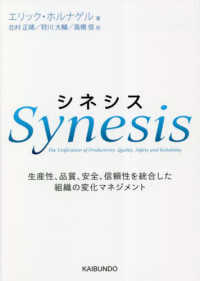- ホーム
- > 洋書
- > 英文書
- > Science / Mathematics
Full Description
Organic Chemistry: Mechanistic Patterns is the very first introductory organic chemistry title that holistically focuses on a mechanistic approach; an approach that has proven to achieve a deeper understanding of chemical reactivity. This mechanistic approach to the dynamic world of organic chemistry visualizes reactivity as a collection of patterns in electron movement, making it possible for students to describe why a reaction occurred. Recognizing patterns of electron flow between seemingly different reactions can allow students to predict how a chemical will react, even if they have never seen a particular reaction before. The text takes great care to establish a progression of reactivity, from simple to complex, introducing functional groups as necessary, while focusing on the reaction at hand rather than the various things that each functional group does.
To help students further visualize key concepts, the text includes Ghislain Deslongchamps' acclaimed Organic ChemWare; interactive animations and simulations that bring static textbook molecular representations to life.
Together, we seek to open students' eyes to the dynamic world of organic chemistry with a more powerful and systematic approach to learning.
Contents
Chapter 1: Carbon and Its Compounds
Chapter 2: Anatomy of an Organic Molecule
Chapter 3: Molecules in Motion: Conformations by Rotations
Chapter 4: Stereochemistry: Three-Dimensional Structure in Molecules
Chapter 5: Organic Reaction Mechanism: Using Curved Arrows to Analyze Reaction Mechanisms
Chapter 6: Acids and Bases
Chapter 7: Bonds as Electrophiles: Reactions of Carbonyls and Related Functional Groups
Chapter 8: Bonds as Nucleophiles: Reactions of Alkenes, Alkynes, Dienes, and Enols
Chapter 9: Conjugation and Aromaticity
Chapter 10: Synthesis Using Aromatic Materials: Electrophilic Aromatic Substitution and Directed Ortho Metalation
Chapter 11: Displacement Reactions on Saturated Carbons: SN1 and SN2 Substitution Reactions
Chapter 12: Formation of Bonds by Elimination Processes: Elimination and Oxidation Reactions
Chapter 13: Structure Determination I: Nuclear Magnetic Resonance Spectroscopy
Chapter 14: Structure Determination II: Mass Spectrometry and Infrared Spectroscopy
Chapter 15: Bond Electrophiles Connected to Leaving Groups: Carboxylic Acid Derivatives and Their Reactions
Chapter 16: Bonds with Hidden Leaving Groups: Reactions of Acetals and Related Compounds
Chapter 17: Carbonyl-Based Nucleophiles: Aldol, Claisen, Wittig, and Related Enolate Reactions
Chapter 18: Selectivity and Reactivity in Enolate Reactions: Control of Stereoselectivity and Regioselectivity
Chapter 19: Radicals: Halogenation, Polymerization, and Reduction Reactions
Chapter 20: Reactions Controlled by Orbital Interactions: Ring Closures, Cycloadditions, and Rearrangements
Appendix A: Answers to Checkpoint Problems
Appendix B: Common Errors in Organic Structures and Mechanisms
Appendix C: pKa Values of Selected Organic Compounds
Appendix D: NMR and IR Spectroscopic Data
Appendix E: Periodic Table of the Elements








